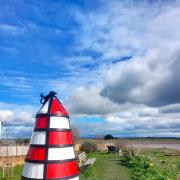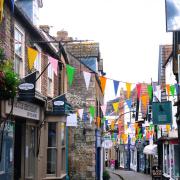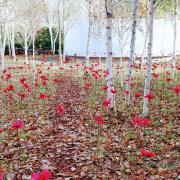Simone Stanbrooke-Byrne encounters jolly cyclists, friendly goats and cheerful birds in an area that’s rich in history and wildlife

The Westhay Moor National Nature Reserve is an historic landscape. Part of the Avalon Marshes in the Somerset Levels, the region has changed hugely over time as sea levels have varied. Westhay Moor has, over the course of aeons, been covered by shallow sea and seen life as, variously, salt marsh, swamp, fen, woodland and the raised bog of accumulated peat. Neolithic farmers eked out a living in the Levels and, latterly, with better drainage, more of the area was successfully farmed and peat extracted.
What was once an industrial site of peat digging has now been transformed by the Somerset Wildlife Trust (SWT) into a superbly rich wildlife habitat, ideal for walking and watching.
Although not en route, I recommend starting your excursion at the Avalon Marshes Centre (see more detail below) to learn more about the area and for a good coffee before driving to the start.

1. The walk starts away from the nature reserve, saving the jewel in the crown for the end.
From the Westhay Moor car park return to the road by the big wooden sign and turn left. The car park is over to your left as you set off along the road, and as you continue Glastonbury Tor appears way over to the right, rising out of the flat lands around it.
In just over 400m you reach the unsurfaced track of Oak’s Drove on the left (it isn’t labelled). Turn left and follow this broad track, its verges lush with wild flowers, which vary with the seasons, and stands of native trees such as birch, oak and alder, all of mixed ages ensuring succession.
The drove passes under trees from time to time; ponds and marshy areas visible beyond them to right and left.
Continue past metal gates on the left (access into a peat excavation area) and watch out for occasional holes underfoot that wait to capture an unwary ankle along the otherwise pleasing and easy-walking track.

2. Almost ¾ mile from its start Oak’s Drove crosses North Drain, part of the network of drainage channels that crisscross the area. Near here we met some delightful animals (not wild) and particularly friendly goats. Keep going beyond the bridge, passing polytunnels over to the right, until you reach the metalled road, North Chine Drove.
Turn right along the road and in less than 100m look for the footpath going left through a metal gate. Take this, walking straight across the field in the direction of the fingerpost, heading towards a small wooden footbridge; Hare Acre Hill rises ahead.
Cross the footbridge over Panborough Drain and continue for another 100m, passing a telegraph pole and following the line of the right-hand hedge.
3. Where this hedge ends there is a meeting of paths (shown on the map, not in the field). If you wish to investigate whether or not the Panborough Inn has reopened you can go right here, following the footpath into Panborough village, but the walk goes left from the hedge-end, still in the same field and soon walking below a thicket of blackthorn and bramble. We met an aloof cat here, who had no desire to associate or be interrupted in his maraudings.
This line brings you to a hedge corner within 150m, where a double-stile-and-plank-bridge combo leads into another field. A badge on the stile indicates that this is part of the Mendip Ring route and the Mendip Group of the Ramblers’ Association has a small commendation here for installing the infrastructure.
Continue beyond the bridge along the right-hand hedge. When this ends keep straight ahead across the field, ground sloping up to the right. This leads to a stile; cross and continue through the next field in the direction of the yellow arrow.
The next stile-bridge combo is solid but unusually angled. Negotiate and continue, bearing slightly right to the visible stile on the far side of a narrow field. Cross the stile and this deposits you on Dagg’s Lane.
4. Turn left down Dagg’s Lane. We met a host of jolly cyclists here, with, refreshingly, not a speck of Lycra, all groaning humorously at the prospect of the hill in front of them; fortunately, our way was level.
In 250m you re-cross the metalled North Chine Drove. Go straight ahead after this, now following the unsurfaced Dagg’s Lane Drove. Look out for the romantic ivy-clad ruins of a red-brick barn in a field to the right.
Dagg’s Lane Drove crosses North Drain again with good views in both directions along the still water. The drove becomes more lush beyond here, with plentiful trees and rich undergrowth. Expansive lakes appear to the right. Depending on the time of year you may spot the furry brown seed pods of reed mace, often erroneously called bulrush.
The drove passes a SWT viewing platform and near here we heard, then saw, bearded reedlings – delightful little birds, listen for their rather metallic ‘chwing’ call.
5. As you walk the final 500m of this drove you will encounter paths going off: the one on the left leads to the Island Hide, where we spent ages watching a great white egret guzzling fish; the one on the right goes more deeply into the reserve, passing the large, family-friendly Viridor Hide and further hides beyond. Take time out to visit the hides and explore the paths through the reserve – you will be well-rewarded. Wooden posts display nature notes, and the Viridor Hide has, as well as a conventional viewing area, a room of colourful artwork depicting what can be seen in the wetlands.
From what was once an area of industry Westhay Moor is now a fabulous SWT conservation area that was initiated back in the 1970s. Old peat diggings are transformed into a network of open water, reed beds and islands, rich with wildlife.
The birds you see will vary with the time of year but a particularly good spring-time treat is a host of migrating hobby. These birds are summer visitors and are often seen in number here at this time of year.
Once you’ve had your fill of wildlife the drove ushers you swiftly back to the car park. Stroll through the portal and along the walkway to admire the arty interpretation boards from local primary schools, inspiring, we hope, future conservationists. A good end to the walk.
Compass points
Maps: OS Explorer 141 Cheddar Gorge and Mendip Hills West 1:25 000
Directions to start/parking: Westhay Moor is north-east of Westhay village, off the B3151, 5 miles north-west of Glastonbury. A parking area serves the Westhay Moor National Nature Reserve at the junction of Westhay Moor Drove and Dagg’s Lane Drove, shown on the map at grid ref: ST456436. No postcode
Public transport: Limited buses run in the area, see travelinesw.com
Distance: Basic walk 3.5 miles / 5.5km, plus additional exploration of nature reserve and to visit bird hides
Exertion: Easy
Terrain: Tracks (sometimes rough) and field paths; brief stretch along very quiet road
Dog friendly: Mostly, but animals grazing and some areas of nature reserve do not permit dogs (except assistance dogs)
Facilities and refreshments: None en route (unless the Panborough Inn reopens: 01934 712554) but nearby villages have pubs and it’s a two mile drive from Westhay Moor to the Avalon Marshes Centre. Here we enjoyed fabulous local crafts and great refreshments – they serve light lunches, drinks, cake etc. Postcode: BA6 9TT; phone: 01458 860556
Wildlife note: Don’t forget binoculars – they bring birds closer. We had a good view of roe deer; secretive otters live here
Simone Stanbrook-Byrne is the author, with James Clancy, of ‘A Dozen Dramatic Walks in Somerset’ and other walking guides for the West Country.


























